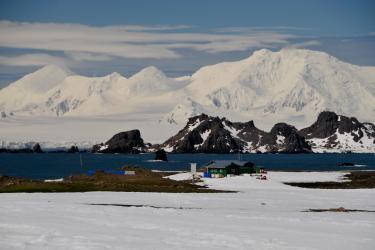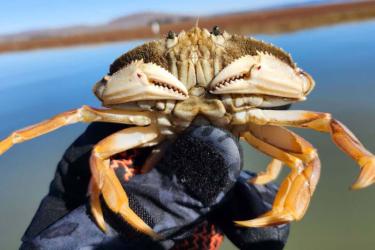An exempted fishing permit (EFP) is a permit issued under authority of the Magnuson-Stevens Act to allow fishing activities that would otherwise be prohibited under a fishery management plan (EFP regulations are at 50 CFR 600.745). These permits are issued for limited testing, public display, data collection, exploratory fishing, compensation fishing, conservation engineering, health and safety surveys, environmental cleanup, and/or hazard removal purposes, to authorize the target or incidental harvest of species managed under an FMP or fishery regulations that would otherwise be prohibited.
Several EFPs have been issued in recent years by NOAA Fisheries to evaluate alternative gears and methods to target swordfish and other highly migratory species (HMS) species in the Eastern Pacific Ocean (EPO). Together with the Pacific Fishery Management Council (PFMC), we have been considering EFPs for alternative gears that will have minimal bycatch and demonstrate potential for economically viable West Coast HMS fisheries. Prior to NOAA Fisheries’ issuing the EFPs, the PFMC reviewed the EFP applications and provided their recommendations.
The PFMC procedures for HMS EFP consideration are found at:
Below is a summary of current and valid HMS EFPs.
Deep-Set Buoy Gear (DSBG)

DSBG employs a hook-and-buoy array gear configuration to target swordfish during the daytime in deep water, with hooks commonly set at depths below 250 meters. DSBG configurations include “standard” buoy gear (SBG) and “linked buoy gear” (LBG). SBG configurations consist of strike indicator buoys deployed at the surface, a vertical mainline, baited circle hooks at depth, and a weighted sinker to ensure that hooks reach depth rapidly. LBG additionally employs surface branch lines connecting the various strike indicator buoys, and more hooks at depth.
Standard Buoy Gear (SBG) EFPs currently valid through December 31, 2023.
Generic permit for Standard Buoy Gear (PDF, 8 pages)
| Standard DSBG EFPs issued for 2023 | ||
|
Vessel Name |
Doc # |
Names of Individuals listed as Authorized Captains on EFPs |
|
Addiction |
CF0551SV |
Zachary Roach |
|
Audax |
CF8370FH |
Dan Fuller, Bill Fuller |
|
Aurelia |
597524 |
William Sutton |
|
BigFoot |
CF0414SH |
Randall Hupp, Mark Hupp |
|
Calypso |
CF6266TF |
Jack Bateman, Gregory Bateman, Russell Marvin |
|
Circle Hook |
1286891 |
Scott Breneman |
|
DEA |
CF0012HY |
Jack Stephens, Ben Stephens, David Stephens |
|
Defiance |
605844 |
Ron Ellis |
|
Diva |
549263 |
Steve Weiser |
|
Dominique Rose |
999497 |
Robert Ashe |
|
Emma Ray |
CF1878ZM |
Stephen Greyshock, Forest Howlett |
|
Entrapment |
928057 |
Andrew Volaski |
|
Epic |
601591 |
Nathan Lins |
|
Espada |
624462 |
Tim Perguson |
|
Extremis |
1051680 |
Jordan Souza |
|
Faith |
595495 |
Michael Mandato, Jedidiah Beck |
|
First Light |
1164782 |
Nicholas Tharp |
|
Fishtail |
1030136 |
Mike Graves |
|
Isla |
26348 |
Miles Wallace |
|
JB |
550580 |
John Ford |
|
Jolene Ann |
CF5821BS |
Sai Fukushima, Chase Fukushima |
|
Jonesita |
CF0552TF |
John Kirkpatrick |
|
Lil Jack |
595177 |
Matt White |
|
Madeline Lauren |
1308449 |
Nick Guglielmo, Nick M Guglielmo |
|
Olinka |
558005 |
Doug Dirkse |
|
Orca |
1298400 |
Andrii Sidielnikov |
|
Pacific Sword |
CF4430GJ |
Bob Ball |
|
Pacman |
CF0863KB |
Ryder Devoe, Fisher Devoe |
|
Patricia J |
585405 |
Kent Jacobs, Toni Gomez |
|
Pilikia |
1134177 |
Sean Burke |
|
Rainman |
1272816 |
Raymond Kennedy |
|
Reel Deep |
901579 |
Blake Hermann, Zane Hermann |
|
Salt & Light |
CF3211JG |
Gregory T. Harold, Timothy Harold |
|
Sandy Bea |
1078115 |
Nick M Guglielmo, Nick Guglielmo |
|
Saronga |
571063 |
Fritz Ahern, Mike Ahern, Max Rippo, Tobin Rippo |
|
Seeview |
CF3571SU |
Kevin Dell |
|
Sharon G |
623518 |
Marc Hermann, Blake Hermann |
|
Spaniard |
559445 |
Fred Hepp, Sean Robertson |
|
Spirit |
611940 |
Anthony Makul, Mike Flynn |
|
Sundowner |
628101 |
Andrew Rasmussen |
|
Tanner Renee |
1085227 |
Greg Gershman, Lauro Saraspe, Tanner Saraspe, Cameron Bingham, Bryon Bingham |
|
Tres Mujeres |
1066033 |
Jack Stephens, Ben Stephens, David Stephens |
Linked Buoy Gear (LBG) EFPs currently valid through December 31, 2023.
Generic permit for Linked Buoy Gear (PDF, 8 pages)
| Linked DSBG EFPs issued for 2023 | ||
|
Vessel Name |
Doc # |
Names of Individuals listed as Authorized Captains on EFPs |
|
Bear Flag2 |
558683 |
Nathan Perez, Thomas Carson, Noah Herrera |
|
Chula |
1217070 |
John Foster, Jim Heflin |
|
DJ |
550062 |
Steve Mintz |
|
Elizabeth H |
644228 |
David Haworth, Nick Haworth, Kris Honings |
|
Gold Coast |
622026 |
Donald Krebs, Alan Felix |
|
Leah Gail |
944172 |
Lance Reinhart |
|
Oriana Z |
CF1742VE |
Austen Brown |
|
Outer Banks |
969797 |
Tim Athens |
|
Pacific Horizon |
627203 |
David Haworth, Nick Haworth, John Vogel, Kris Honings |
|
Piky |
570036 |
JJ Gerritsen, Gregory Minobe |
|
Sea Haven |
635102 |
Arthur Lorton, J. Anthon Lorton |
|
Shearwater |
1259460 |
Markus Medak, Daniel Fuller |
|
St Aniello |
559214 |
Romolo Ghio |
|
Three Boys |
CF2036TJ |
Kelly Fukushima, Sai Fukushima |
|
Trailblazer |
610884 |
Mark Lebeck |
* LBG EFPs may fish a combination of LBG and SBG

Reports from the Active 2020 EFP fishermen (pdf)
A summary of the 2020 DSBG EFP data can be found on pages 3 - 4 of the NMFS report to the Council.
Recent EFP recommendations were made by the Pacific Council at their June 2021 meeting.
Longline
Longline fishing gear consists of a horizontally-strung main line up to 100 kilometers (km) in length, supported at regular intervals by vertical float-lines connected to surface floats. Descending from the main line are branch-lines, each ending in a single, baited hook. A longline exempted fishing permit (EFP) was issued in 2019 that allowed two vessels to fish longline gear (both shallow-set and deep-set) for a 24- month period in the exclusive economic zone (EEZ) off California and Oregon. Terms and conditions of the permit specified that fishing must take place outside of the Southern California Bight and seaward of the leatherback critical habitat area, or 50 nautical miles from shore, whichever distance is greater. Additional terms and conditions included observer coverage on all trips, night setting of shallow-set longlines, protected species interactions limits, total hook and set limits, specific no-fishing areas, gear, bait and operational techniques. Issuance of the EFP was followed by litigation, in which the court ruled in favor of the plaintiff and vacated the EFP in December 2019.
NOAA Fisheries intends to prepare an Environmental Impact Statement to assess a broader range of alternatives for the proposed action to fish with longline gear in the U.S. West Coast EEZ under an EFP. The purpose of this EFP is to allow a limited amount of exploratory longline fishing to (1) determine whether this type of fishing for swordfish and other highly migratory species (HMS) species is economically viable, and (2) assess the type and extent of interactions with protected species and non-target finfish. The Pacific Fishery Management Council recently recommended NOAA Fisheries authorize deep-set buoy gear for targeting swordfish. However, it is unclear that deep-set buoy gear will be an economically feasible substitute for drift gillnet gear, which is currently used to harvest higher-volume catch of swordfish and many other marketable HMS. Therefore, it is important to continue to test other gear types, like longline, which U.S. fishermen successfully use to target swordfish and other highly migratory species in federal waters off the Pacific Islands, and in the Gulf of Mexico and Atlantic Ocean.
Frequently Asked Questions
Which regulations describe the process for obtaining an EFP?
Regulations that describe the application and review process for EFPs are at 50 CFR 600.745. Regulations specific to HMS fishing are at 50 CFR 660.718.
Who can apply for a West Coast HMS EFP?
Anyone who is planning HMS fishing activities that would otherwise be prohibited by the regulations may apply to NOAA Fisheries West Coast Region for an EFP. The permit is issued to the applicant but a copy must be on the assigned vessel at all times during EFP fishing activity.
How do I apply for a West Coast HMS EFP?
Follow the procedures detailed in 50 CFR 600.745. Send your completed application to Chris Fanning at chris.fanning@noaa.gov in NOAA Fisheries West Coast Region, and contact him with any questions via email or (562) 980-4198. Applications received will be considered by the West Coast Regional Administrator.
How long does the application review process take?
It depends on the complexity of the project and PFMC’s meeting schedule. NOAA Fisheries recommends allowing the PFMC to review the application and considers the PFMC’s comments on each application.
NOAA Fisheries may need to conduct an environmental analysis of the impacts of issuing the EFP. This document would support the decision-making and inform the public of the EFP action. The Regional Administrator will consult with the PFMC before issuing an EFP. This usually involves a Federal Register notice of the receipt of your application, and discussion of the proposed activity at a PFMC meeting. Applicants should plan on at least 9 to 12 months from the date of application submittal before the EFP is issued.

